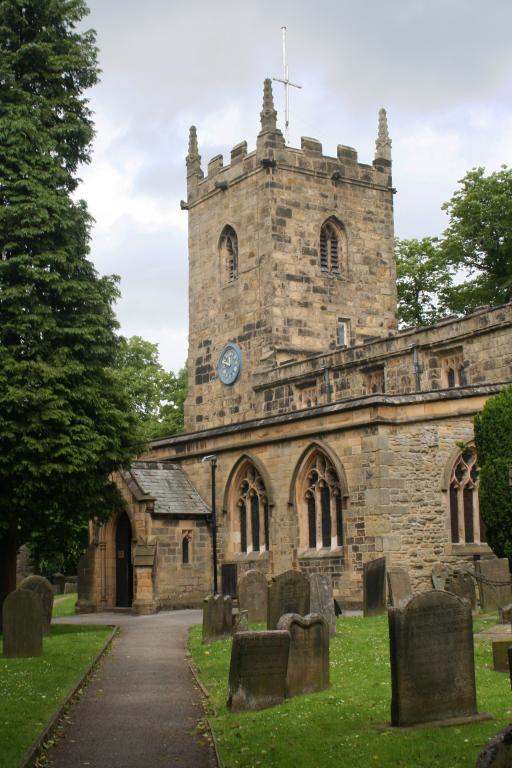As Chris Gehrz remarked recently, many Christians right now are avidly looking for texts and stories that illuminate the response to plague and pestilence through the ages. There have been so many blogs and columns on many sites about the Cyprianic plague in the third century, about Luther and Zwingli in the sixteenth, about the influenza crisis of 1918. Here is another story, and, I would say, one of the most powerful. It is very famous indeed in Britain, but as far as I can tell, scarcely known in the US. It’s the story of Eyam, and it makes for good Lenten reading.
Eyam is a village and parish in the outrageously beautiful Peak District of Derbyshire, in the English north Midlands. Although in older times it was described as being remote, it stands only about fifteen miles from the city of Sheffield. Like much of England, in the seventeenth century Eyam was deeply divided between those who supported the established Church of England – the Anglicans – and those Puritans who opposed it, who were Independents or Presbyterians. The established church returned to power in 1660, and in 1662, any minister who would not agree to the new settlement was ejected from his parish living. In Eyam, that meant that Puritan Thomas Stanley was ejected, to be replaced by the Anglican rector, William Mompesson.
Alan Fleming: Creative Commons License
The world then changed in 1665, the time of the so called Great Plague, which was actually not the most lethal in terms of the pestilences of the day. It just happened to be commemorated by Daniel Defoe in the novel he published long afterward, Journal of the Plague Year (1722), but which was taken as sober history. As such, that book has totally shaped our image of the time.
Not the worst of its kind, perhaps, but that plague was still devastating enough. Mainly concentrated in London and Cambridge, the great question was how far it might spread to other parts of the country. In 1665, a merchant brought some cloth samples to Eyam. Those samples carried fleas, and the fleas carried bubonic plague. People began to die.
The horrors lasted for some months, but then relaxed, the deaths ceased, and people breathed again. But a new wave then started in mid-1666, and at that point, the community made its historic decision. Led by their two rival ministers, Mompesson and Stanley, the villagers resolved to quarantine themselves within the bounds of Eyam, lest they transmit the curse to surrounding areas. That would mean large market towns like Sheffield and Bakewell, and beyond that, through the whole midlands and north of England.
That was a voluntary decision, not imposed by any central authority or police. As they knew very well, hundreds would die, to save the lives of tens of thousands. Even more impressive, they did not decide something that they need only maintain for a few traumatic days. They maintained their vow for half a year, through the end of 1666. By that point, at least 270 residents had died, out of a probable total of 800 or so. As for conditions under isolation, in November 1666, Mompesson recorded that “my ears never heard such doleful lamentations — my nose never smelled such horrid smells, and my eyes never beheld such ghastly spectacles.”
A ”quarantine”. by the way, comes from the words for forty days, quaranta giorni. This particular self-isolation lasted much longer.
Later historians have somewhat qualified the original story. They show for instance that Mompesson tried desperately to get his own wife Catherine to leave (she refused, and died, aged 27). The proportion of casualties to the original population was a little lower than is sometime claimed. From a large literature, Patrick Wallis did a fine study of how interpretations of Eyam had changed through history, entitled “A Dreadful Heritage: interpreting epidemic disease at Eyam, 1666-2000” (2005: well worth downloading). It offers a great example of shifting constructions of history. But even when we make all those allowances, the basic story stands intact. The people of Eyam really gave their lives for others.
The story of “The Plague Village” became a legend, part of national folklore, the subject of books, plays and documentaries. There are museums, monuments and commemorations. The village maintains its annual Plague Sunday. You can see the key sites of the story, including some of the plague stones that the villagers erected, marking the area that neither inhabitant or outsider should cross, and where outsiders left food and medicine. You can see the graves where Elizabeth Hancock buried her husband and six of her children, while avoiding infection herself.
Even this month, when BBC News is trying to look at the reactions of ordinary British people to the restrictions they face in light of the current virus, where else should they turn for interviews except to Eyam? Eyam is a shrine commemorating extraordinary heroism, and extraordinary faith.














